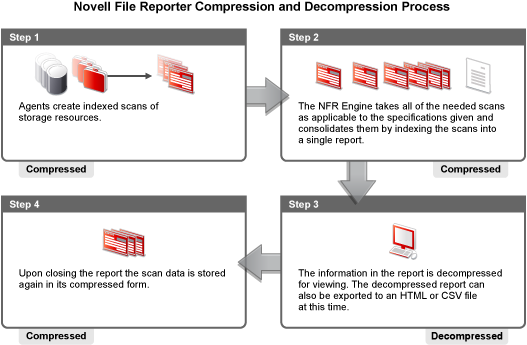1.3 NFR Engine
The NFR Engine is the mechanism that runs Novell File Reporter. It can reside on a Novell Open Enterprise Server running SUSE® Linux, a SUSE Linux Enterprise Server, or Microsoft* Windows Server 2003 or 2008. In a small organization, the NFR Engine can be run on a server that is also used for other purposes. In a larger organization, the NFR Engine should run on a standalone server.
The NFR Engine does the following:
-
Schedules the scans that are conducted by the NFR Agents
-
Processes the scans and compiles them for inclusion in a report
-
Provides all of the report information to the user interface
-
Determines that a condition has been met to start a triggered report as opposed to a scheduled report
-
Monitors how many agents are online
1.3.1 NFR Agents
NFR Agents are compact programs that run on many types of commercially available operating systems, with more planned for the future. Currently, NFR Agents are available for Novell Open Enterprise Server 2, SUSE Linux Enterprise Server, Novell NetWare®, and Microsoft Windows Server 2003 or 2008. NFR Agents can examine and report on a variety of file systems, including Novell NSS, Traditional, NCP™, Windows NTFS, Reiser, and ext3.
IMPORTANT:For optimal results, you should install an NFR Agent on every server that has a volume you want to report on.
NFR Agents cannot be installed on NAS devices or clustered hardware devices. For Novell File Reporter to report on these type of devices, NFR Agents can be set up as proxy agents. Novell File Reporter 1.0.2 only supports proxy agents in Active Directory managed networks. For more information, see Configuring Proxy Agents for NAS Devices.
1.3.2 Scans
Through the NFR Agent, Novell File Reporter takes a “scan” of the file system of the storage resource at the moment it is examined. A storage resource can be a server volume, a Novell Storage Manager policy, a network folder path, or a Linux* mount point. The scan includes comprehensive information on file types being stored, if these files are duplicated, where duplicate files reside, when files were created, when files were last opened, and much more.
Scans can be taken at any time, but we recommend using a scheduled time after normal business hours to minimize the effect on network performance.
Scans are indexed and compressed data that is specific to a storage resource. Scans are decompressed only when data within the scan is used to generate a report. In other words, a scan of a particular storage resource is utilized only if it includes content that is part of the specifications of a report request. For example, if an administrator runs a report specific to user home directories, and all of those directories are located on two volumes, the scans that the administrator uses to generate the report are only the two scans from the two specific volumes, and not scans from the other storage resources.
Scans are both indexed and compressed because of their potentially large size. Indexing means that certain data—such as a file owner’s name—is stored just once in the index, with pointers to all files owned by that user. Additionally, the scan is compressed. By using both indexing and compression, the scan is stored at a fraction of its actual size. For example, a decompressed scan of a single storage resource with 12,000,000 files is 1.44 GB. Indexed and compressed, the scan is 464 MB.
NOTE:Procedures for performing scans are documented in Section 4.0, Scheduling and Performing Scans.
1.3.3 Reports
To generate a report, the NFR Engine takes all of the needed scans that are applicable to the specifications of the report and consolidates them by indexing the applicable scans, into a single report.
With terabytes of information being examined and reported on, the decompressed report can be in the gigabytes. For this reason, when you view a report, or more likely, very specific information through a filtered report, Novell File Reporter decompresses only the information you want to see from the report for viewing on a computer workstation monitor.
Figure 1-2 Compression and decompression process

NOTE:Procedures for generating reports are documented in Section 5.0, Scheduling and Creating Reports.